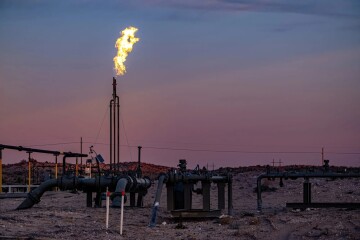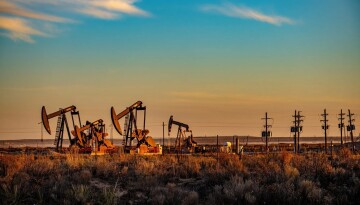By Molly Montgomery, Searchlight New Mexico
At first, in the haze, they look like birds, perched on fence posts along the road. But they don’t shift or take flight, and there’s one on every post for as far as I can see. They are upside-down boots.
The road, Buck Jackson, cuts south through southeastern New Mexico, across the fields where companies are drilling for oil. I drive for almost 3 miles before I stop seeing boots above the sparse grasses and the thorned mesquite and the trash. A Chevron sign marks a plot of land beside them, and the heavy silhouettes of pump jacks and processing plants hover behind them. Bootheels point up to the sky.
The oil workers wore them. Then they retired and hung them up, or traveled to oil fields elsewhere and hung them up, or died, and their relatives and friends placed them there. On a black rubber boot, in white marker, someone wrote “6/13/20, R.I.P.” and a name that has worn away.
“They leave their memories there,” a former oil worker, who asks to go by the pseudonym Diego García, tells me. García, 36, is undergoing chemotherapy treatments for acute lymphoblastic leukemia (ALL), which he developed while cleaning sites contaminated with drilling waste. He’s worried that employers won’t hire him again if they learn he spoke to a journalist. “Some people leave pants, too.” He laughs.
I think about what the workers stood on when they wore the boots — rigs, spilled oil, tanks, truckbeds, caliche — and how many hours they wore them, during shifts that could span five straight days and nights, no sleep. These were hours of absence, when the workers were away from home, and the people who loved them couldn’t see them. And the fence becomes a fence between the fields and home.
Separating from the world
“A good day,” said Marcos Carranza, “is a day without danger.”
It’s 6:30 p.m. or so, November, at a house in the city of Hobbs, about an hour northeast through the fields from Buck Jackson. Two highways that lead to the worksites cross through town: State Road 18, north to south, and U.S. Route 62, west to east. Billboards for injury attorneys mark city boundaries. At night, the neon signs and floodlights of hotels and motels illuminate the highways. The parking lots are full of work trucks. The hotels are interspersed with smoke shops and restaurants and stores that advertise workboots and beer. Rows of houses, mostly brick with pitched roofs, line the quiet streets that stem from the highways.
The Carranza family’s front door is wide open, a rectangle glowing bright on the dark row of houses. The children and grandchildren of Carranza and his wife, María Elena, sit together on big couches beneath family photographs. The rich smells of rice and chicken with mole rise out of pots and pans on a table in the back of the room. Carranza is at the table, exhausted. He got home maybe 20 minutes ago from his job constructing pipelines for an oil company.
“A bad day is an excess of hours working and a lot of danger, because you can fall asleep driving, or on-site, and a machine hits you, and you can lose your life,” he says. (We’re talking in Spanish, which I use when interviewing most of the workers I meet.)
On previous jobs, Carranza says, he’s had to enter tanks where oil and natural gas are stored, to clean them. The containers are metal and round. They usually range in size from 10 feet tall and 12 feet wide to 30 feet tall and 15 feet wide. Even in bigger ones, it’s difficult not to feel claustrophobic inside. They contain hydrogen sulfide, a gas found in natural gas deposits. Exposure to low levels can cause nausea, headaches and insomnia. Exposure to high levels can cause memory loss and death.
“Sometimes when you wash the tanks, hydrogen sulfide is released, and when that happens, you can pass out,” Carranza said. “That would be a very bad day.”
Though he’s never passed out himself, he’s seen fellow workers collapse many times. Sometimes they survive falling into the liquid at the bottom of the tank. Sometimes they don’t.
Over the chatter of television news, Carranza’s children and grandchildren are teasing each other and arguing about politics. His voice mixes with theirs as he tells me about a slower, quieter toll the industry has exacted on him over the past 17 years. He’s 67 and technically retired, but he receives no employer-sponsored benefits, and the meager Social Security payment he gets — around $1,000 a month — isn’t enough to sustain his family. He’s continued to work for the oil and gas industry, at $16 an hour, 50 or 60 hours a week, because it’s “the economic activity of New Mexico,” he said.
The companies that have employed him haven’t consistently provided proper safety training or equipment, and the exposure to dangerous chemicals and loud machinery is gradually separating him from the world. He can’t smell the dinner María Elena prepared. He thinks it’s because he’s inhaled so much hydrogen sulfide, which can cause olfactory paralysis. He’s losing his vision, hearing, and memory.
Because he’s losing his memory, he loses hours on the road. He’ll be driving somewhere and suddenly can’t remember why he’s there or where he’s going. He can’t drive María Elena to medical appointments because he has to work during the day. He turns his head to show me a golf ball–sized lump in his neck and says he’s not sure whether he’ll be fired when he asks for a day off to go to the doctor.
“The money that one earns, one pays a very steep price for,” he said. “There are times when I’ve felt depressed. You work so much, but it’s not worth it, because health can’t be bought. And there are irreversible effects, and you can’t be the same as before. As much as I want to think well, see well, I can’t now.”
Because of his disabilities, he can’t find other work. He’s so experienced at building pipelines that he can keep doing it despite the challenges he faces. No one else will hire him.
“There’s no alternative,” he said. “My back is against the wall.”
'Thank you, Chevron'
When I look out my car window at the gas flares leaping into the sky, I imagine the roar and snap of flames. According to data compiled by the Centers for Disease Control and Prevention (CDC), 60% of all workers in the “mining and oil and gas extraction” industry have been exposed to hazardous noise and a quarter have difficulty hearing.

But on the dirt roads beside the flare stacks—the tall metal chimneys where gas is being burned off the crude oil so that it doesn’t explode—all I hear of the flames is a rush of heat through metal pipes. It’s hard to distinguish it from the whoosh of moving trucks, which you could pretend is the sound of the ocean that filled the Permian Basin hundreds of millions of years ago, were it not for the clank and rattle of equipment and the constant machine buzz.
The sea creatures and algae in the ancient ocean decomposed into the oil that a water-well driller found south of Carlsbad in 1901. Speculators began drilling throughout southeastern New Mexico. Nearly three decades later, in 1928—with crews working 12-hour shifts and sleeping in bunkhouses full of rattlesnakes, and wooden rigs catching fire and burning to ash—they struck enough oil to start a boom. Within two years, 20,000 people flocked to Hobbs, according to the New Mexico Institute of Mining and Technology.
New Mexico’s dependence on oil and gas revenue is historically high: Roughly 40% of the state’s general fund comes from fossil fuel production in the Permian Basin, in the state’s southeast corner, and in the San Juan Basin, in the northwest corner. Drilling in the San Juan has been slowing down, but the Permian, which covers roughly 86,000 square miles in eastern New Mexico and west Texas, is booming. It’s the most productive oil field in the United States. Almost half of all U.S. oil comes from the basin, and about a third of that comes from New Mexico. As a producer, the state is second only to Texas, which has a larger share of the resource.
In the counties of Lea, Eddy, Chaves, Otero and Roosevelt, New Mexico’s Permian covers around 13,000 square miles. When people fly over the region, they see a flat, mottled landscape with various small cities—Hobbs, Artesia, Carlsbad, Lovington—clumped around highways.
Throughout these communities, you can smell the hydrogen sulfide. People suffer from cancers, respiratory illnesses, chronic nosebleeds, headaches, and thyroid problems—all conditions that have been associated with industry air pollution. Creosote and mesquite choke out native grasses. Among the creosote and the mesquite are old tires and beer bottles and Red Bull cans and broken pipes. Birds ingest toxins and have been seen falling dead out of trees and sky, and the noise and the floodlights interfere with animals’ circadian rhythms.
“They can’t sleep, they can’t eat properly, they can’t properly forage for food and they can’t reproduce,” said Charlie Barrett, a field ecologist and thermographer with Oilfield Witness, a nonprofit that uses infrared cameras to expose emission levels.

In Hobbs, there are pump jacks on signs and murals around town. In Carlsbad, Jozee Zuñiga, an environmental activist, tells me that representatives of the oil companies give children coloring books and tell them about how they protect animals in the fields. “The school I went to my last two years of high school has a ‘Thank you, Chevron’ on its sign because Chevron donated to fix the school’s labs,” she said.
She tells me that support for the industry drowns out any talk of workers’ conditions. At local boutiques, she sees hats that say “Rig Daddy” and shirts that say “Permian Proud.” She went to a feed store to pick up dog food and heard a man at the register shout at the cashier, “Drill, baby, drill!”
“It’s not only their livelihoods, but it’s the culture that they participate in,” she told me. “If you speak out, or you go against the grain, you are considered a threat. And not just a threat to a company or a specific procedure or operation. People consider you a genuine threat to their personhood, their lives.”
Zuñiga’s father was a supervisor in the oil fields before he passed away in 2016. She still has his work number in her phone, and his work clothes and boots are in a closet. She describes herself as privileged, because his hours were somewhat regular, but he was always on call, even during vacations, and he woke up at three every morning to head for the job.
“I remember hearing him walk down the stairs,” she said. “And I remember being so excited some days coming home from school, because, from the road, I could see that his truck was already there, and he had come home early. But that was not all the time.” Some days, coming home, she still looks for his truck.
“I'm so grateful to the people who get up every day and do the work in the grueling and the awful conditions,” she says. “But I want people to know that, yes, we depend on it. Yes, we need it. But that doesn’t mean we have to surrender.”

